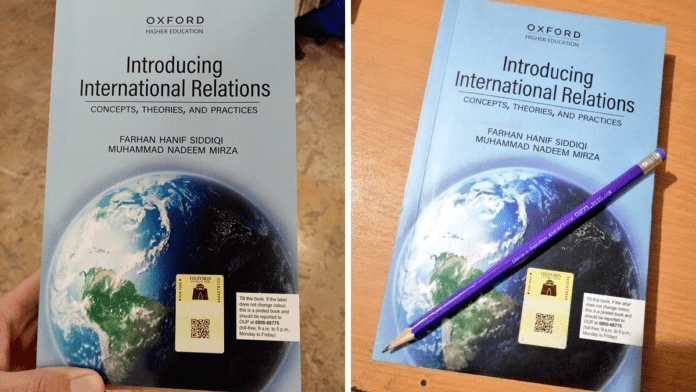Introducing International Relations is an insightful and comprehensive guide to understand the theoretical dimensions of the International Relations (IR) discipline and the application of core concepts of IR in the contemporary world politics. It is a co-authored study carried out by two Islamabad-based eminent scholars, Farhan Hanif Siddiqi and Muhammad Nadeem Mirza. Both are formally associated with the Department of International Relations, Quaid-i-Azam University and having reputable standings in their peer groups. The combined efforts of both authors tried to cover the core themes of the IR and made efforts to explain the evolution of the international system and its contemporary status.
The main structure of the book is divided into sixteen short chapters, and every chapter encompasses a separate topic respectively. The first chapter starts the debate by introducing the IR discipline and the evolution of the international system, which passed through various phases.
The book’s introductory pages slightly touch on the scope of IR in Pakistan while providing a two-paragraph history of IR discipline in Pakistan (p. 17-18). The second chapter of the book emphasizes the nature of the international system, and the debate in this chapter consists of the positions of state and non-state actors in the present world.
This chapter explains the major turning points in the world’s history formed by several factors such as Empires, Civilizations, Wars, Peace Treaties, and Revolutions. These factors mainly shaped the changing attributes of the international system. The second chapter described the presence of state and non-state actors in the world.
However, a detailed analysis concerning the diverse characteristics of these non-state actors appeared in the fifteenth chapter of the book. The international intergovernmental setups of states, regional organizations, non-governmental organizations and the clandestine functioning of certain terrorist groups are called the powerful non-state actors in the fifteenth chapter (p. 404-405).

After introducing the core theme of the book and the varying characteristics of the international system in the first two chapters, the third chapter summarized the primary theoretical debates of the IR discipline. The mentioning of China Pakistan Economic Corridor (CPEC) as a Student Thinking Exercise reassured the relevance of the book’s arguments with contemporary Pakistan’s standing in the evolving contemporary geo-economic competition of great powers (p. 71).
The fourth chapter is an exceptional feature of the book which has rarely been emphasized in the existing studies of the IR discipline. Doing Research in International Relations: Methodological Debates focused on the essential steps one can follow in conducting research on the real developments of the world.
The subsequent chapters of the book emphasized different topics of International Relations, such as Foreign Policy in the fifth chapter, Dimensions and Balance of Power in the sixth chapter, Strategic Studies and War in the seventh chapter, Arms Control, Disarmament, and Nuclear Non-Proliferation in the eighth chapter, and Conflict Resolution and Peace Studies in the ninth chapter.
Moreover, the discussion on International Law in the tenth chapter, International Political Economy in the eleventh chapter, Environmental Degradation and Preservation in the twelfth chapter, Feminism and Gender in the thirteenth chapter, and Identity, Nationalism, and Ethnic Conflict in the fourteenth chapter attempted to present an updated description of contemporary world politics.
The conversation on the United Nation’s seventeen Sustainable Development Goals (SDGs) and the significance of different perspectives on gender issues are the interesting points of the twelfth and thirteen chapters, whereas the rise of populism in different countries are the fascinating topics of the fourteenth chapter.
The last chapter of the book concluded the book based on the future of International Relations based on various new developments consisting of Brexit, the Arab Spring, the US-China Trade War, and issues in South Asia and Afghanistan (p.442-447).
Based on these descriptions, this book is an enlightening account of various conceptual portrayal of contemporary world politics and its changing attributes throughout history. This book provides an engaging and comprehensive overview of the IR discipline, which comprises a concise account of conceptually convincing explanations of world politics. This book could be treated as an essential reading for the students of social sciences generally and the IR specifically.
It is a valuable addition to the existing literature on IR, which could be considered an appropriate academic source for people from academia and anyone interested in developing a solid understating of the IR subject. There are a number of exceptional features that have made this book an outstanding and updated account of the contemporary international system.
This book could be equated with the World Politics: Trends and Transformation of Charles W. Kegley and Shannon L. Blaton and the International Relations of Joshua Goldstein and Jon C. Pevehouse. To understand the intellectual contributions of the writers, it is more appropriate to read the scholarly works of both authors consisting of various research papers on different topics.
In addition to the book under review, the intellectual efforts of the two have always tried to provide a new dimension of IR discipline to the students of IR and Politics. The Islamabad-based leading intellectual and policy circles have also acknowledged their contributions in the field of IR.
Therefore, this co-authored book could be considered as an appropriate account of IR discipline based on Pakistani perspectives which has established a new precedent for other local authors about the formulation of Pakistan-specific academic approaches of IR.





